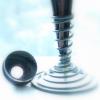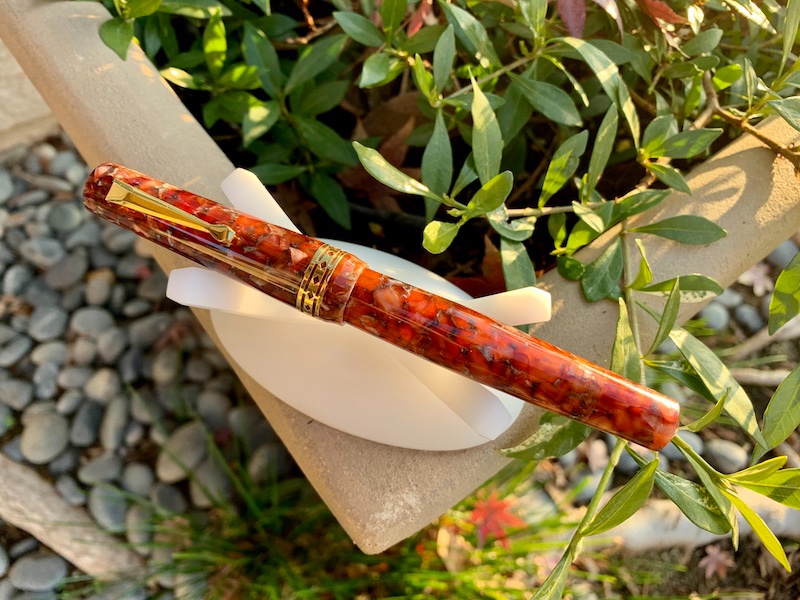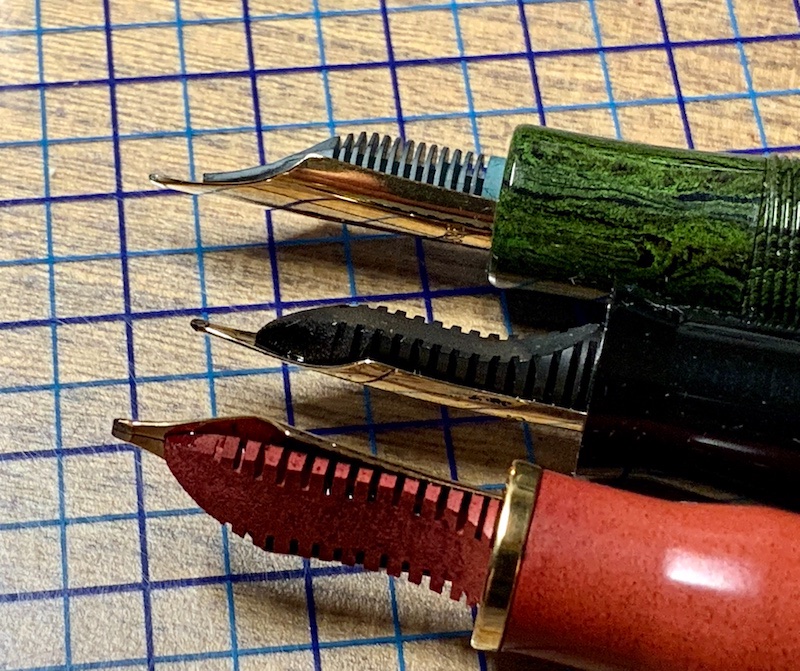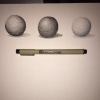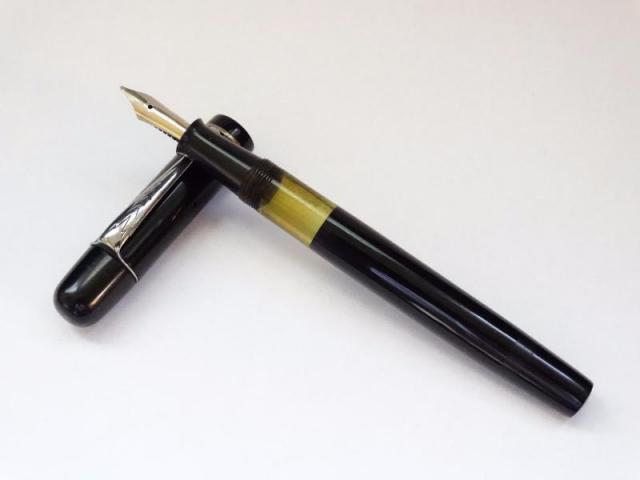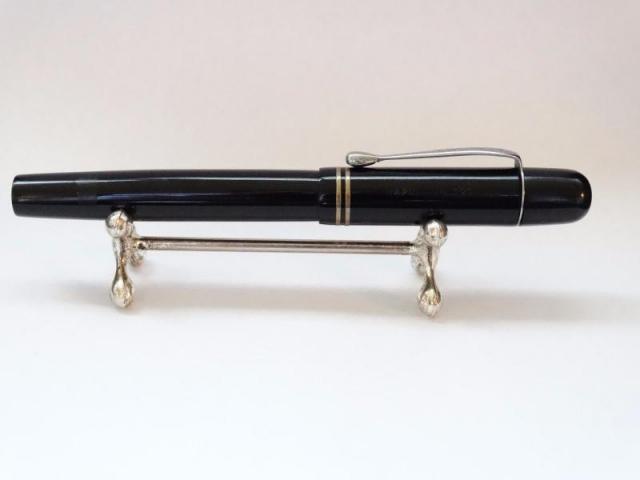Search the Community
Showing results for tags 'piston filler'.
-
(filled with Rohrer & Klingner Alt Bordeaux) Demonstrators are not really my area. I do somewhat appreciate them as a sort of curiosity, but I prefer more traditional finishes and colors. That being said, a piston filling demonstrator does seem like an interesting idea, and since I've never had one and lately it became possible to buy them for less than $20, I thought I'd try one. I already had the solid black Wing Sung 698 so I wanted something different (and while I do like WS 698, I'm not that crazy about its design). So, Caliarts Ego II it is. To be precise, I ordered the first Caliarts Ego, which had a very different clip and an opaque black piston mechanism, but ended up receiving the second version. Deciding that it's not worth to make a fuss about it, I accepted what I got. Caliarts Ego II is a clear demonstrator, and when I say clear, I mean totally. The only elements of it which are not transparent are the nib and the clip. I do like the design of this pen, much more than Wing Sung 698's. It's just more neat, better shaped and the clip is much better looking. For the record, Ego II also comes with the piston knob and the cap finial opaque in a few colors (those seems out of stock on eBay now) and one fully solid color in a very bright blue. The pen came in a steel box, packed with a little wrench for disassembling and a spare feed and EF nib, while the one on the pen is marked as F. Both nibs are stamped "Caliarts Iridium Point". I think those are Pilot 78G/Metropolitan/Plumix etc. compatible nibs but I haven't tried any swapping. The wrench quickly proved useful. At first glance I noticed that the piston didn't come all the way up as it should. So I took the wrench, and not really knowing what I was doing I tried to twist the piston. There was some noise, for a second I thought something cracked, but no, surprisingly the piston went up to the exact position I wanted it to be. Now, however, it doesn't come all the way down. The piston seems to be too short to fully utilize the pen's ink capacity on a single filling, but this can be easily remedied by pushing the air out and drawing ink the second time to fill the pen completely. I filled the pen for the first time with Pelikan 4001 Dark Green and it didn't write well out of the box. It was very dry and required some pushing to get a consistent line. First I thought about opening up the tines of the nib little more - the nib on the nail method (as demonstrated by SBRE Brown). Done wonders for my Parker Sonnet but here it was completely unnecessary and it was probably a bad idea, but the unexpected result is worth mentioning. I slightly pushed the nib on my nail... and the nib instantly bent. I mean instantly. I didn't even use much force, I barely started, and the nib just completely bent immediately as if I hit it with a hammer. I thought I broke it and would to have to get another nib, but no, another surprise, as easily as it bent it got back to its right position. The nib seems to be perfectly fine. The dryness was actually a slight baby's bottoms. Not having any micromesh I decided that rather than spending $25 on the sheets I'm going to spend ca. $2 on the three grit nail file at the nearest drugstore. Did the job, the pen writes like a charm. Smoothly, moderately wet, with some feedback that I find pleasant. The nib is a stiff one, a little bit of line variation is possible, but you'd really have to force it. The cap is screwed on. That's always a good thing. Posting is possible, I guess, but not really useful. It posts very shallowly on the piston knob and not even securely. Also, posting makes it very long, and the pen is already pretty big without it. Caliarts Ego II did bring me some annoyance, two times I thought I broke it. After just a little work with the nib, it turned into a very pleasant writer. A piston filler, good ink capacity, and very affordable. If you like demonstrators then I think it's worth getting. It probably won't become my EDC, but overall I'm glad I have it. Measurments: Lenght capped - 142 mm Lenght uncapped - 131 mm Cap lenght - 60 mm Lenght posted - ca. 170 mm Barrel diameter - 13 mm Weight (half inked): Capped - 18 g Uncapped - 13 g Cap - 5 g (the feed is clear, but the pen was inked when I took the photos) Size comparison. From the top: Jinhao 159, Caliarts Ego II, Wing Sung 698, Pelikan M200
- 4 replies
-
- caliarts ego
- piston filler
-
(and 3 more)
Tagged with:
-
Review Of Kanwrite Heritage - In Medium And Fine
TheVintagelife posted a topic in Fountain Pen Reviews
So here are some thoughts on my two Kanwrite Heritage pens - One in Green marbled pattern and the other in Blue marbled. One with a Fine nib (currently the blue, but it changes), and one with a medium. I will also talk a bit about writing with the KW Fine Flex nib which had brought separately for another pen (this is I think the same nib as the Noodler's flax pens). TLRD: the pens are great value for a price of under $30; the nibs (and feeds) and ergonomics are the real stars. Filling mechanism is dependable. The body is pleasing to the eye albeit without feeling premium (but acceptable quality for this price). Review: Intro and Choices available. The Kanwrite Heritage is a largish piston filler pen from Kanwrite or Kanpur Writers, a pen nib manufacturer based out of Kanpur, India. The pens come into a huge variety of colors, solids, translucents and certain marbled patterns. I find the marbled patterns the most pleasing to the eye, and out of a shortlist which also included the excellent looking red marbled variant, I chose the green and blue marbled versions (mainly because I have an OCD of matching inks to pens, and I have (and write with) a lot more of greens and blues than red. Another combination that I personally would wish to see would be one with a black cap and burnt-orange body - I think it would look great on this pen. I haven't seen one around, but if you wish, the there are black pens and burnt-orange pens readily available for a cap-swap (if you are willing to be stuck with another pen with the reverse combination...). Kanwrite makes their own nibs, and as I will talk in detail below, they are generally very good. They have a huge variety of nibs, not only the usual F,M and B, but unusually for the sub INR 2000/USD 30 market, they also offer EF, BB, Fine flex, and an extra-fine flex also. All choices, however, may not be available with all retailers. They also have a 14K gold nib which looks very similar to an Aurora 88 and is excellent (however, I find the gold nib an overkill for a pen in this range - I would get it for a custom hand turned pen (as I have), for which there are lot of good options in India. To make matters easier, Kanwrite will send you the nib, on your request, pre-fitted into a Bock or JoWo housing. Appearance & Design (1-10) – 8 The pens come in marbled plastic bodies with gold accents. there is a thick cap ring, a clip supported by a visible clip ring and a ring between the barrel and the cap protecting the piston knob. Uncapping the pens, one finds an ink window (very useful since its an opaque body piston filler) rimmed by two more gold rings, cap threads and a girthy and reasonably long section that slopes down gently and flares slightly, but abruptly near the nib. Both the marbled patterns are quite attractive, to say the least. These are injection moulded CAB plastic though, not PMMA/ acrylic, let alone hand turned, so lacks the visual depth and chatoyance of marbled resin. The marbling is on the surface itself and does not glow from within like the latter material. That said, I find it very pleasing to the eye on its own right. The marbled patterns are multi-colored (not just white, but veins of other colors too) and this creates various points of interest while looking at the pen. From a design perspective, whether consciously or otherwise, there are some similarities wit the Aurora Optima family of pens; especially the shape of the clip and clip ring, the cap band and bands on both sides of ink window and above the piston knob, and, the size and placement of ink window itself. These are not unique design concepts however, and the pen retains enough individuality to stand apart as a unique design. For one, it is more than a full centimeter (about half an inch) larger than the Aurora (coming in at 140cm closed to the Aurora's 127) - a much nicer size for my preference. Also the piston knob cap and top finial have the same color as the rest of the body. But the most 'interesting' departure is the shape of the top of the cap - instead of a regular softly squared off design, Kanwrite has gone for a slightly weird reverse cone top sitting rather awkwardly over the clip ring - I am not sure it works as a design choice - it seems stuck on as an afterthought. Nevertheless this is a substantial looking, attractive pen. Apart from that off-putting cap-top, everything comes together very well. the choice of gold accents work well with the marbled colors. the nib is perfectly proportional to the body. the proportions of the various segments and the angles and slopes are spot on from any angle. Interchanging the caps makes for a fun look too! 2. Construction & Quality (1-10) – 8.5 Coming back to the CAB plastic material, it doesn't feel as dense and premium as resin, but it is indeed sturdy and durable. At this price point, you are not likely to get premium materials - though some stuff out of China can feel as though they are)The same can be said of the metal trims - well if they are metal at all - apart from the clip, I am not sure. But the plating seems well done and likely to last. The pen looks like it can take rough use and that is the most important thing at this price range. None of the components or the pens as a whole, feel 'cheap' (though you probably couldn't fool anyone its high end either - unlike the case with some Moonman/PenBBS pens in the same range. opening the cap reveals a plastic knob to activate the piston. The knob and the piston itself are clear(ish) plastic - again nothing fancy, but feels solid and up to the task. Weight Dimensions & Ergonomics (1-10) – 9 This is a largish pen without stepping into the oversize territory. To get the numbers out of the way, these are: Length capped = 140-141 mm (5.5") Length uncapped = 129-130mm (5.1") Length Posted = 161 cms (6.3") Ink window = 5mm (0.2") diameter at section = 11-12mm (0.4 - 0.5") weight capped/posted = 21gms weight uncapped = 15 gms Here is a comparison of the pens posted and unposted: I like pens which I can comfortably use unposted, and this usually means a sweet sweet between (capped/ uncapped) 125/135mm and 150/160mm - so this is right in the sweet spot for me. Here is a comparison with some other pens of this price range range that I find very comfortable to hold (well, probably a stretch including the TWSBI in this price range, but what the hell!) the pens are also very light and the caps do not add much to the weight if you are fond of posting. Ergonomics is one area, where, at least for me, the pens really excel. They just has that right combination of length and light-weight to act as an EDC. The pens balance well in the hand, whether un-posted or posted (which they do securely) and the section shape and girth are comfortable for me also. Well to nitpick, I'd have have preferred a more gentle upward curve to the rim (nib-side) instead of the slightly abrupt ridge; but this is relevant only for those, like me, who hold the gen very low. Even then, its not uncomfortable as such (since the ridge is not sharp), but you know its there. Nib & Performance (1-10) – 9.25 The nibs are broad shouldered understatedly attractive Indian #35 (#6 type) nib and is perfectly swappable into Bock or JoWo housings (and vice versa, I would assume). In fact the same KW nibs are offered pre-fitted in Bock or JoWo housing by Kanwrite. Since there are two nibs on review, I will discuss them in turn: The fine is about a half a size finer than a typical Jowo or Bock fine (though some Bock fines I have used are similar) - its similar to a sailor MF. It has a pleasant sort of feedback but is not scratchy or unpleasantly toothy. with very dry inks (like my Krishna Ghat Green), the sense of toothiness may increase so better to use with well lubricated inks. I really do like this KW fine very much - with a Pilot Iroshizuku or Sailor Shikiori inks, it really shines. the nib has is quite hard, though it has slightly more spring than a jowo - about same as a bock. the feedback this nib gives is excellent for a controlled handwriting. The medium is closer to a JoWo medium but probably a hair finer; hence a more typical medium line width. It is smooth and tuned very well right out of the box. There is nothing to dislike about the medium nib Between the two, I personally prefer the fine by a hair's width, but that is just down to writing preference. Many will prefer the medium. Both nibs wrote well out of the box. Both pens were tuned very well for optimum wetness. The feeds are thick ebonite ones which seems to regulate flow quite well; though there are very occasional overly wet starts when the pen has been moving around int he bag (this is common and not a problem) Nibs are easy to change out as the whole housing disengages by unscrewing it from the section. Kanwrite nibs, where available, are quite affordable. As a case in point - I had also (earlier) separately procured a KW 'Fine Flex nib'. It is probably the same as used in Noodler's flex nibs. I wouldn't use it for these pens as it steel colored (though these are also available in two tone) while these pens have gold trims. I am currently using it in a Moonman T1 where it performs very well (though only after I adjusted the Moonman feed to supply the extra flow required). In hindsight say the extra-fine flex would have been preferable for exploring the full breadth of line variations possible... Filling System & Maintenance (1-10) - 8.75 It is a piston filler; which while (thanks to the Chinese) is not exactly unheard at this price point these days, is nice to have. The piston works smoothly. I get about about 2ml ink into it per fill (give or take) which I think is quite optimal - more than that is probably not ideal for someone like me who has more than one, couple of, quite a few pens inked at one time! Cleaning thoroughly is possible as disassembly is quite easy. the plastic knobs feels a little flimsy but its protected, and not something would need heavy handling. Cost & Value (1-10) – 8.5 In India, the KW Heritage is likely to cost around INR 1700-1800 (about USD 25); but expect to pay about $5-10 more if buying outside India, which is understandable because of customs, logistics and shifting exchange rates etc. While at this price, it is most certainly a 'good' value, the exact score is a little tricky, because, frankly, getting a great value pen at around $30 is no longer unheard of (as it was a few years ago) due to the introduction was several great models at this (or even lower) price points by the likes of PenBBS, Moonman and Wing Sung (among others). For example: 1) Moonman T1 is a piston filler made of attractive anodized aluminium which feels more premium in build but is cheaper 2) The materials in PenBBS piston, vac fillers and other special-filler pens (especially the quality of acrylics used; and also metal pistons, vacuum plungers etc) such as the 309, 456, 355 and 500 feel more premium and 'high-end' So, as a value proposition, it would not be fair to say that the KW Heritage is miles ahead of the competition. However, and this is a big point, at least for me, I feel that the nibs in these pens are at a different class from all the Moonman & PenBBSnibs I've tried. I've had to change the nib on every, but one, of my PenBBS+Moonman pens into JoWos/ Bocks (or in the case of the T1 - the KW Fine flex!) . I found those pens to generally have dry and less than satisfactory feeds as well - no comparison to the one the one on the KW (ebonite or otherwise) in terms of flow regulation. Some may like these pens out of the box, but for those opting for a nib change, that's an added cost to be factored for these Chinese pens. Another thing is that Kanwrite provides various nib options from EF to BB as well as F and EF in flex. Most Chinese pens at this range come only in a couple of widths (F and one of EF or M). So, overall, considering the writing quality and nib options, this is still an extremely good value. Conclusion (Final score, xx/6) - 8.55 I find these pens to be good looking, sturdy and comfortable to write with. They are dependable and affordable. They write very well every time. So overall, I would recommend these pens heartily as an EDC or for your collection. Some writing samples showing the line widths of the various nib sizes I have are below:- 17 replies
-
This is my first Santini fountain pen and it's the one I like more till now. I'm a fountain pen lover and my favourite ones are my ebonites. They are all hand crafted by artisans. The one I introduce you now is the Santini Libra Voyager with the superflexy nib. It's a bit special because it's made with care and love by Italian craftsmen who know well their work. These are my first impressions more than a review. Appearance & Design (10) In my view, it's appearance is beautiful. The swirls among blue, turquoise, green, magenta and black in the ebonite are always very nice to watch, it's mesmerising if you turn the pen. The material is precious (rubber with sulfur, badly named as hard rubber); it's name comes from it's similarly with ebony. The design is very well thought-out. It is uncapped in one and a quarter turn. The clip is long but is very tight (too much). The section is long and very comfortable to hold and it tappers up at the end a bit preventing your fingers to meet the nib. It's gurthy enough for my liking. The Santini 18 kt gold nib (superflexy in this piece) has one advantage: you can interchange with other Santini nibs. It can be posted very securely but I do not recommend you to do it because with time you can damage the surface of the ebonite (if you like posting, do it with care). The pen is exquisitely beautiful and the workmanship is top notch. The ebonite warms to my hand and the pen is a comfortable writer. Construction & Quality (9) Outstanding construction and quality. The pen is beautifully made. Ebonite is a precious material for me. The fountain pen is handcrafted (I give a high value to pens made with experienced hands more than inyected plastic, for example). This pen is made by artisans and well engineered. The quality of the threading is outstanding. It has very comfortable long section. Perfect and beautiful cap band. The clip is very tight, it's a pity. It's the only bad detail and that's the reason to have a 9 instead of a 10. The polishing is very good and the pen is full of well made details. I remember that Da Vinci said "details make perfection and perfection is not any detail". Weight & Dimensions(10) Weight: 31g Length: 145mm. 135mm uncapped Cap length: 68mm Cap diameter: 17mm Body diameter: 15mm (max) It has a perfect balance. It is a not very lightweight nor heavy and comfortable pen. It's a gurthy pen but not too much, I feel that dimensions like the perfect ones. The grip is 11.4mm at its narrowest and is very comfortable between your fingers. It's slightly hour-glass shaped and flares out closest to the nib so your fingers won't slip. Nib & Performance (10) The nib is a Santini 18kt gold extra fine and flexy (they call it superflexy but it's really a nice and very good semi flex), so it's performance is assured. It does not require a lot of pressure to flex but it doesn't open like a wet noodle. It writes beautifully and with very good and nice line variation if you want and very good snap back. You can choose among plenty of different nibs with different sizes (it's one of the best companies if not the best in the world about offering diferent nib options) and plating. Mine has a bit of feedback (I prefer that characteristic better tgan the glassy nibs) and it's juicy, without being a gusher. The nib comes with an ebonite feeder to keep a well flow. Santini makes their nibs and I really appreciate that. I think in Italy only Aurora and Santini make their own nibs. Filling System (10) I like piston filling systems. The pen encapsulates a Schmidt piston component with a ratcheting sound that alerts you when you've filled the pen completely. It has a ink capacity around 1.1~1.2 ml. Schmidt is a well-known German quality brand and their piston component is reliable and as sturdy as a classic piston filling system. If you have any problem, Santini has a repair service that if it is like their fabulous customer support and service, I wouldn't think about that. I know you have to store the pen with care and without light and to dry it well after washing but I prefer the feeling of ebonite when you touch it and it looks beautiful. Cost & Value (10) The quality/price ratio is very good. 369 € including shipping is a fair price. But the good point is it's value, it's a fountain pen made by hand, if you take only that into account, it's real value is very high. Beside that it's made with care and love and perfectly engineered. Katrina (customer service) is so kind and professional. The way she supports and deals with you is outstanding and they send you the pen very fast. Conclusion (Score, 59/60) I feel very happy with this fountain pen. It is beautiful and very well made, with love by artisans. Very well engineered and thought-out. I am also very satisfied with their customer kindness. I think we do well to support handcrafted fountain pens. I am perhaps a bit viassed because I do love ebonite. The price is more than right if you consider the artisan work. They are all craftsmen. They also package the fountain pen beautifully. Santini does not appear to invest in marketing and I think they sell most of their products directly to the end customer. I think that their pens are of perhaps superior material and quality than the better known Italian brands. This pen will remain one of my best. I have become a fan of Santini. I would like to give my congrats to all Santini team, they are great. Best regards to everybody. Take care Miguel Ángel.
- 10 replies
-
.thumb.jpg.4b37dd6ffcffa13f64fb1de9f17d4a22.jpg)
Santini Libra Ebonite with an EF "superflexy" nib - initial impressions
Vintage_BE posted a topic in Fountain Pen Reviews
I have not yet posted a review on FPN, and I am a bit skeptical about reviews of recently acquired pens. I received this pen on 11 March 2021 and nevertheless decided to write a quick review for two reasons. First, I want to join in the praise that several other FPN members have heaped on the company for their stellar customer service and - communication. Second, I’d like to share my (initial) experience with their EF-tipped “superflexy” nib, since there appears to be some confusion as to the availability and characteristics of that nib. I will skip the customary “first impressions” section of the review template since this review is a first impression in its entirety. I bought a Libra Ebonite pen (in the “Lava” design), at the (then discounted) price of €359 (including shipping). Appearance and design: I have enclosed a few pictures. This is an oversize pen (see below for dimensions). As noted in other FPN posts, Santini's color schemes sometimes come across as rather baroque (not to use the term gaudy), however the “Lava” version seems inspired by the vintage “woodgrain” design that was popular with Waterman, Conway Stewart and other brands in the 1920s-1930s. The vintage aspect of the Libra is reinforced by its flat-top design (it reminds me of Conway Stewart’s 55 Duro model). The cap ring is perhaps a bit massive for my taste and the same goes for the “Santini Italia” inscription. The ebonite versions of the Libra (25 of them, when I checked their website, but they may be adding more) are all “limited editions” - i.e. limited to 33 pieces each. The serial number is etched on the top of the cap. In summary, perhaps not a pen to uncap in a meeting where you intend to keep a low profile (but then most meetings are videoconferences nowadays). Construction & quality: Santini advertises their pens as "100% made in Italy". I have no reason to doubt that claim, and my initial impression is one of high quality materials, genuine craftsmanship and careful finishing. No loose or wiggly parts, the ebonite has been polished to high gloss, the cap engages perfectly with the threads. And their nib is something special (see below). Weight and dimensions: The Libra measures 14.6 centimetres capped, 13.5 centimetres uncapped, and sports a hefty barrel that comes to 1.5 centimetres at its widest spot. The section is exceptionally long. Like I wrote, a truly oversized pen. It is slightly longer and significantly heftier than the Pelikan M1000, generally recognised as oversized (see enclosed picture). The ebonite barrel and cap help to keep the weight down (31 grams capped), in spite of the built-in piston component (see below). I have big hands and welcome pens of this size. You could post it but that would make the pen really too large for my taste. Nib & writing performance: This is why I am posting this review. Santini is one of the very few remaining fountain pen companies that manufacture their own nibs. Their website (https://www.santini-italia.com/nib-size-guide.html) gives the impression (perhaps deliberately) that the “superflexy” nib is not available in EF size, and states that the EF tip puts down a line with a width of 0.5mm. I had a (web-) chat with Katrina, one of the family owners and deservedly famous on FPN (and elsewhere) for being exceptionally responsive and flexible (in a commercial sense of course). She confirmed that they would be happy to prepare a superflexy nib with an extra fine tip - without surcharge by the way. The Santini superflexy nib comes with an ebonite feed which is claimed to improve ink flow. It’s difficult to verify such a claim (I do not have a Libra with a plastic feed) but I can confirm that my Libra yields a decent ink flow, in spite of its EF tip. My Libra does have noticeable feedback (as you can expect from any EF sized tip), but that helps to control the nib and does not result in a “draggy” feel. And what about the “superflexy” feature? My Santini nib is flexible, a bit less than the Pilot 912 #10 FA and the Montblanc Calligraphy nib, a bit more than the Jowo “soft” 14K nib (the one with the sideways cut-outs). When used at what I consider to be normal pressure, for writing cursive with a 55° right slant, Santini's superflexy nib does not produce significant line variation - but then almost no contemporary nib does that (the Pilot #10 FA being the exception in my limited experience). You certainly can squeeze line variation out of this nib, when writing vertical script and applying an amount of pressure that (in my view) is hard to sustain for more than a few lines (yes, I am one of those who believe that fountain pens are best used with a very light hand). I hasten to add that the superflexy nib has immediately become one of my favourite writers (and like many FPN members I do write with a rather large number of pens). It has a very pleasant bounce that helps to put down a nicely rounded, flowing script. And - other than what the Santini website states - my extra fine tip actually is an extra fine, and perfectly suited for cursive writing with an x-height of 2.5 mm or even less (see enclosed picture with ruler). In other words, Santini seems to have overdelivered - something I have not yet experienced when purchasing a fountain pen. Once again, this is a first impression after just four weeks of use, but I expect that this nib will remain one of my favourite writers in the longer term. Filling system and maintenance: Santini advertises the Libra as having a “piston filling system” and from the outside it does look exactly like a piston filling pen (without an ink window though). As other FPN members have noticed (see https://www.fountainpennetwork.com/forum/topic/348301-santini-italia-libra/?do=findComment&comment=4388621), the pen encapsulates a Schmidt piston component. That makes it a pen with a “built-in converter”. Compared to a standard converter, the Libra can be filled (and flushed) without having to first unscrew the barrel. However, its capacity is that of a converter, ergo a (bit) less than the capacity of a typical (think Pelikan) piston filler. A standard converter can be taken out of a pen (like a cartridge), which allows for easier flushing/cleaning of the pen. And if a standard converter fails, it can simply be replaced by another one (which usually costs less than €10). That being said, I have been using converters for many years, and have not yet been confronted with one that stopped working. Also, Schmidt is a well-known German quality brand and I have no reason to believe that their piston component is less reliable or sturdy than a classic piston filling system. And if worse comes to worst, Santini has a repair service. If that service is on par with the finishing of their pens, and with their customer service, I would not lose sleep over the continuing functioning of the Libra’s piston filling system. Cost, value and conclusion: at a price of €359 (VAT excl; at a VAT rate of 21% the price would be 434€, and I believe they regularly offer discounts) this is a proposition that is hard to beat. Santini may not (yet) have the reputation and prestige of brands such as Visconti, ASC, Leonardo and Scribo. They do not appear to invest in marketing and I think that they sell most of their products directly to the end customer. But my initial impression is that their pens are of the same (or perhaps superior) material and quality as/than the better known Italian brands. I suspect that this pen will remain one of my better purchases. YMMV of course.- 47 replies
-
- flex nibs
- ebonite fountain pen
-
(and 3 more)
Tagged with:
-
A little backstory so you could understand: My first pen is a Pilot mr and now I'm currently looking for a step up. I have been looking for Pelikan and sailor pens, but also TWSBI (for it's relatively low price). The pen I'll get will be my workhorse pen and for Twsbi I'm between the 580 and the vac700r. I want to hear the experience of people who have used these pens for prolonged writing, if they recommend TWSBI and if yes, which one of them. Note: I know the difference between european and japanese nibs
- 50 replies
-
- twsbi
- piston filler
-
(and 1 more)
Tagged with:
-
Twsbi 580 Or Conklin Word Gauge Piston Fillers
fabian3194 posted a topic in Fountain & Dip Pens - First Stop
Hi, I'm deciding between two mid-priced piston fillers; either the TWSBI 580 or Conklin Heritage Word Gauge. Apart from the small price difference which pen would you choose and why ? Especially like to hear from those who have both. TWSBI pros: easy to disassemble and clean Cons: chance of cracking/fragile, #5 nib limits availability of nib options (eg italics, gold flex and specialty grinds etc) Conklin: pros: no history of cracking, #6 nib more freedom of nib options (eg italics, gold flex and specialty grinds etc) cons: not designed to be disassembled Thanks- 15 replies
-
Here I present to you all a vintage mid 1950's MAHAG piston filler by Kaweco FOA , thanks to all the vintage Volkswagen fan over at multiple automotive online groups and forums who answer my questions and give info For a bit of History , MAHAG is a major automotive dealer in Germany starting out in 1930's and still around today, after the war they center all theirs on Volkswagen and added Porsche. Just as any other of such they give company branded merchandise to customers and also employees. This pen as far as info and speculation goes ( according to the Volkswagen fans ) was only given to priced customers who purchase up market model like the Karmann Ghia, Porsche or the full option Beetle or the famed 23 windows bus and also likely to distinguished employees. It's actually a rare item accordingly. A fascinating and interesting piece of automotive and fountain pen memorabilia. This pen was OEM manufactured by Kaweco and everything tells , the piston mechanism had the distinctive pin through the knob construction and the whole pen exhibit a variety of the Sport model's character. It had the model 12's piston mechanism but it's got the early post war 112 construction of mix celluloid + ebonite BHR. It had a Bock 14C gold nib that is fine and surprisingly soft and almost full flex. With an all round cap with the MAHAG logo Technicals and restoration info on coming post
-
I have one of the new Leonardo Momento Magico, piston filling pens. It has a 14Kt stub nib and an ebonite feed that are friction fit to the section. I was having problems with ink flow. After completely filling the ink chamber, the nib wrote beautifully, until the ink stored in the feed while filling was exhausted. Then it stopped writing. It seemed the feed was not getting ink from the piston. After trying a few different inks, I filled the pen again, but left the chamber about 20% un-filled. The pen seems to be drawing ink normally now. I can rationalize this behavior, but I have never experienced it before with any of my other piston fillers (Stipula, Pelikan, Aurora, etc. Maybe the Leonardo is easier to fill completely. I dunno, so I'm looking for comments, experience, etc. David
- 10 replies
-
- ink flow
- piston filler
-
(and 1 more)
Tagged with:
-
“First look” Review: Radius1934 Superior Primissima Monterosso Introduction Radius pens were made in Italy from 1934 until sometime in the 1950’s. Very little is known about the history of the brand, even by such authorities on Italian fountain pen history as Letizia Jacopini. Here is a link to her brief article: Radius - FountainPenwww.fountainpen.it › Radius. Apparently, Radius was the top of the line brand of its parent company, S.A.F.I.S. And the Superior was Radius' top of the line model. It was made in Turin, as is the Radius1934. The Radius1934 company was established quite recently, and has just issued their first product, named “Radius1934 Superior Primissima” after the founding date of the original company and their best-known model. I believe the founder of the new company is a collector of Radius pens. I do not know if he has any connection with the historical company. This pen was released in 5 resins, each named after a different one of the Cinque Terre villages on the Ligurian coast of Italy. Each color was limited to only 12 pieces. I was fortunate to be able to secure one in the Monterosso (marbled red) color. I ordered mine with a broad nib which I had custom ground to cursive italic. First Impression, Appearance and Design The Radius1934 Superior is a standard tapered cylinder with conical ends. It is about the same size as a Pelikan M800. I was impressed with both the look and feel of the pen. The materials and fit and finish exude quality. The section is tapered with a flare at the end. It is very comfortable for me. The cap unscrews in about two turns. The clip is the same design as the vintage Radius Superior. It goes into a shirt pocket easily and holds securely. Size comparison: Left to right - Pelikan M800. Leonardo Momento Zero Grande. Aurora 88 (with custom binde). Radius1934 Superior. Nib and Performance The 14 Kt nib is reported to be made by Bock, but the feed appears to be a custom ebonite feed. The feed appears identical to that made by Leonardo for their Momento Zero Grande pens. The nib has rather long tines and is just a little flexible and springy. My nib was custom ground by the “nib whisperer” (his self-designation) who works for the vendor. It is moderately smooth and very crisp, loaded with the Radius-branded ink that came with the pen. With this ink, the nib seems on the dry side but with consistent flow and quick starting after an overnight rest. Feed comparison (All with Bock #6 14Kt nibs): Top to bottom - Standard Bock Feed. nib. Radius1934 Superior Feed. Leonardo MS Grande Feed. Writing Sample Filling system The Radius1934 Superior is a piston filler. The pen fills in 10 turns of the piston. The piston appears to be stainless steel and feels very solid. It turns smoothly. It seems to hold just about 1 ml of liquid. Cost and value This pen is priced at around USD500. It is at the high end for a resin pen, yet less than many pens of similar quality with gold nibs and piston filling. I judge it to be fairly priced. Conclusion Radius1934 is a new pen company producing pens modeled after those of the historic Radius pen company. Their first release is a very limited edition of 60 pens in 5 resins - black, amber, red, green and blue - each named after one of the Cinque Terre villages. On first encounter, this seems to be a top quality pen. It is well made with attractive materials and high-end features. I am happy to find another new Italian pen maker of fine writing instruments, and I am looking forward to what other pens they will release. I will update this first look after I have used the pen for a while, if further experience dictates a need. David
- 22 replies
-
- radius1934
- italian pens
-
(and 4 more)
Tagged with:
-
Suggestions for Indian Ebonite Piston-filler pens!
Srjan posted a topic in India & Subcontinent (Asia)
Can any one suggest me some Indian handmade ebonite piston-filler pens? I know of Noodler's Konrad Ebonite and Narwhal Schyulkill Eobnite 365, but I want an Indian handmade one. Does anyone in India make such pens?- 13 replies
-
- ebonite pen
- piston filler
- (and 6 more)
-
I wanted to change inks and so followed the directions for disassembling and cleaning the piston, and everything seemed alright. I cleaned, then reassembled my pen, reapplied some silicone grease around the piston, and tried to fill the pen... and it will draw only a few drops of ink! What am I doing wrong? What can I do to get a full fill of ink? Normally I'd estimate a full fill at better than 2ml of ink...
-
Hi, I have just acquired an Esterbrook in a job lot of old pens and would like to bring it into use. It currently has an empty old Esterbrook cartridge fitted. Can anyone advise what cartridges will fit? It is much longer than the 'common' cartridges you see around. Also from an environmental perspective is there a filler e.g. pistion filler I can use? Not sure what model, but if I can work out how I will post a picture in this part of the forum. Just been looking at Esterbrook.net and think it is a CX-100 model with a red barrel :-) Many thanks, Julian
- 21 replies
-
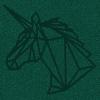
Dollar 717I - The Most Underrated Pen Ever? Written Review + Bonus Pictures
Sui-Generis posted a topic in Fountain Pen Reviews
- 17 replies
-
- review
- piston filler
-
(and 2 more)
Tagged with:
-
In January this year, I was pleased to discover that the folks at Fountain Pen Revolution (FPR) were releasing a new pen. It looked pretty appealing on their Facebook page – and as a frequent visitor to their store, I was keen to get a look. So I emailed Kevin from FPR and asked if he’d be willing to give me a ‘sneak preview’ of the pen, so that I could review it here on FPN – and offered to pay for the privilege. Kevin insisted on sending me two free ‘samples’ – one in solid blue and one demonstrator. These have now been in my possession for about a month, and I’m pleased to be offering what I hope is still an impartial review! Long story short: if you’re familiar with their existing line-up, I’d say this pen sits above the Dilli and the Guru, both in terms of appearance and quality, but is not quite in the league of the Triveni (and the Triveni Junior) – as reflected by the asking price, of US$17. This is a good, sturdy, and attractive piston-filler pen, that’s easy on the eye, comfortable in the hand, and glides smoothly across the page – and all for a very reasonable price. ______________________________________________________________________ 1. Appearance & DesignThe first thing I noticed about the Indus from its photographs was the clean lines of the pen, and the prominent gold-coloured furniture. This looked like a quality pen, with a style somewhat reminiscent (intentionally or otherwise?) of a higher-end Pelikan. Nor did it disappoint once I had it in my hand - it’s pleasantly weighted and well-constructed. The clear demonstrator model is definitely my favourite – the clear plastic not only provides a view of the ink sloshing around in the barrel, but makes it possible to watch the piston mechanism (also made of clear plastic) in operation. The solid blue pen (with clear ink window) was probably the more ‘professional’ looking in the pocket, though. The gold trim on both pens is very attractive – though the clip is not entirely to my taste, but more on that later! These are pens I’d be happy to give away as a gift, without feeling that they would come across as ‘cheap’. http://i.imgur.com/uqvVYry.jpg http://i.imgur.com/qq7KQLd.jpg I should also mention up-front that a week or two after these pens arrived in the mailbox, FPN member ‘mehandritta’ posted a review of a very similar looking pen, just developed and released by the Unique Pen Company of Indore, India – the Click Majestic Pen (https://www.fountainpennetwork.com/forum/index.php/topic/285118-click-majestic-pen-review/). Kevin from FPR was happy to confirm for me that Unique Pens are manufacturing the Indus pen bodies for him: The design of the non-translucent Indus pens is based on another Unique pen, the Oliver Tulip (AKA the Click Neo Tulip, available from ASA Pens), albeit with some minor modifications and design improvements, which required the creation of new mouldings for manufacture. The clear-body pen was, I believe, designed and developed at FPR’s request and to their specifications – but there was no exclusive supply arrangement, so Unique are free to manufacture and merchandise these pens under their own branding, as indeed they are doing! … 2. Construction & QualityIf you’re familiar with FPR’s earlier offerings (the Dilli and the Guru), you’ll know they’re made of fairly inexpensive plastic – it does the job, but it’s not the most attractive. The Indus really steps this up a few notches. The demonstrator is made from clear ABS plastic, and is quite see-through. The whole piston mechanism (with the exception of the seal) has also been made from clear plastic, which I think is a very nice touch. The solid pens are apparently constructed from a higher quality acrylic, which likely means they will prove more durable than the demonstrators. I like the fact that the grip section and the piston filler knob are both reinforced with a metal ring, which will hopefully reduce the risk of cracking. http://i.imgur.com/CAUWAAk.jpg The pens look and feel well-constructed. The cap threads are smoothly machined, and provide an airtight seal with the barrel to prevent evaporation and dryout of the nib – I’ve had no hard starts in the 3-4 weeks I’ve been using them. Earlier prototypes of the solid pens apparently had problems with leaking at the seal between the acrylic and clear plastic (viewing window) portions of the barrel – I experienced this myself, with a pre-production version of the pen that was sent to me in error – but the final product is free of these problems. My one quibble with these pens – and it’s only a small thing, really! – is the clip. I like the way it’s integrated in with a metal band that encircles the ‘crown’ of the pen – as mentioned earlier, the cap especially is reminiscent of Pelikan’s design for its M-Series pens. I just wish, though, that they hadn’t replaced the ‘pelican bill ending’ characteristic of its inspiration with such a large, rounded protrusion – more reminiscent of a proboscis monkey!! The material is very sturdy, which means it holds firmly to the pocket once clipped in – but it’s also very tight, and can take a little bit of effort to clip it on in the first place. … 3. Weight & DimensionsI’d class the Indus as a small-to-medium, fairly slim-line pen – similar in size, maybe, to the Pelikan M400 or M600? [My pen budget hasn’t stretched yet to include one of these…]. Weighing in at ~15g, it’s quite light, so that the weighting of the pen was never an issue for me. It’s evident that the ‘solid’ and demonstrator pens were produced from different mouldings – there were slight differences (1-2mm) in these measurements between the two, with the solid blue pen slightly shorter across the board. Capped, the demonstrator version pen is 13.3cm; uncapped it’s 12.5cm, and sits comfortably in my hand. The pen posts fairly snugly (a little more securely on the blue pen, for whatever reason) – at ~15cm, it’s still a good fit, and given the lightweight material the shift in balance is not an issue. The pen cap has a 13mm diameter at its widest point; the grip section is 10mm at its widest point, just above the cap threads. I tend to hold it a little further back, at the junction between the thread and the ink window, and find this very comfortable for extended writing sessions. http://i.imgur.com/On29rsR.jpg http://i.imgur.com/kl6QrlA.jpg … 4. Nib & PerformanceAs with most FPR products, the nib is the real highlight of the pen. The Indus takes the new two-tone #5.5 nibs, and uses the same plastic feed as the Dilli and the Triveni. The blue pen came fitted with a Fine nib – pleasantly smooth with just a hint of feedback. The demonstrator pen came with a flex nib, and was customised for maximum flow. Beautifully smooth, the feed had no trouble keeping up with the demand for ink with the tines spread for flex writing. http://i.imgur.com/xPIX0pn.jpg http://i.imgur.com/r0blBpR.jpg I’ve now tried all the of the #5.5 nib sizes and I can recommend them all, with one caveat: the EF nibs can be a little scratchy ‘out of the box’, and require some smoothing. For me, this is the biggest selling point for all FPR pens: their original #5 nibs were fantastic value for money, although the earliest iterations were a little lacking in presentation and ‘flair’. The #5.5 nibs are a definite step up in every way, at no added cost. I’d love to have the option of a stub nib, though – and maybe a double- or triple-Broad, as the broadest option right now lays down a line that’s not much wider than the Medium. http://i.imgur.com/tQOJQrL.jpg … 5. Filling System & MaintenanceThis is one of the main selling points for the Indus: the pen is a clutchless piston filler (whatever that means!), which operates smoothly and can be fully disassembled for cleaning and lubrication. I am not a fan of the Dilli at all – I’ve owned a few of them, but find it extremely frustrating that I can’t properly access the barrel to clean it out. Both the Guru and the Indus are a huge improvement on that score. I haven’t measured the barrel capacity on this pen – I’d be guessing it can hold a little over 1-1.2ml. http://i.imgur.com/h9XN7k8.jpg … 6. Cost & ValueThe Indus is now listed on the FPR website as ‘coming soon’, with an advertised price of $17 for regular nib sizings – add a further $3 for flex or broad nib options. With a flat rate delivery charge of US$3 to anywhere in the world, this is a pretty good pen for a very reasonable price. No-one is going to mistake this for a Pelikan (unless they don’t know their pens!) – but it’s a nicely styled, durable plastic pen, with a piston filler mechanism to boot! … 7. ConclusionI’m very grateful to have had the opportunity to test out the Indus, and want to thank Kevin from FPR for providing them free for the purpose of doing this review. I’m impressed with the look, the feel and the performance of the Indus – I think the FPR Guru is a pretty good buy too, at US$9, but for the extra cost you get a better looking pen, made of more durable materials. …
- 16 replies
-
- indian pens
- fountain pen revolution
-
(and 1 more)
Tagged with:
-
I read about a new pen from Taiwan called Penlux,big pens piston filled.I will like to know opinions about it before trying to get one. Thanks in advance.
- 4 replies
-
- penlux
- taiwanese pens
-
(and 1 more)
Tagged with:
-
Hello friends. I always look for value-for-money fountain pens. That’s because my pens go through a lot of rough usage and handling during busy OPD hours at hospital and it’s impossible for me to pamper them in a desirable delicate manner. Reliability of a fountain pen is my greatest concern and by this word “reliability” I mean the ability of a fountain pen to perform each and every time it is put to paper. Leaks, burping, dry start, scratchiness are strictly ‘no-no’ when it comes to the urgency and gravity of the situations that my pens have to go through. Kanwrite Heritage is one such ‘Reliable’ piston filler. Why I like it: Very good quality piston filler at a very affordable price and with varieties of nib options. Kanwrite is a stationary production house based in the erstwhile Manchester of the East, The Industrial Hub of Uttar Pradesh, Kanpur. Those of you who have some experience with ‘Noodlers’ Ahab pen might recognize this name, as this company manufactures and supplies parts (or whole) of many of Noodlers flagship models. The history of this company is relatively young, with Shri Laxmi Shankar Awasthi, presently mentor, together with his sons Pradeep and Sandeep, founding this company in 1986 with an aim to “……provide consumers with the best quality fountain pens at most ‘easy’ price.” Now the ‘easy’ part is not that easy after all when we consider Indian market scenario for fountain pens. In most parts of the world where fountain pens are still considered practical and popular, the starting price for a good standard fountain pen is few times greater than the price expectations for a similar type of model from Indian ‘consumers’. Working inside that limitation and coming up with a good practical piston filler at the price point, Kanwrite heritage is one great mid-level fountain pen, that has the potential to cater to both entry level fountain pen enthusiasts and seasoned users alike. All parts are made in house and that makes it a truly greater experience. The Kanwrite heritage 1. Appearance & Design: This is a rod shaped well designed pen, with multiple parts assembled to form the final shape. It is almost spindle shaped when capped, with middle portion much thicker and both the body and cap tapering towards blunt ends. The cap has an inverted cone shaped screw or finial that pins the clip to the tapering upper end of the cap. The clip is chrome coloured with ‘Kanwrite’ imprinted on it. It’s a bit stiff and tight for my taste, but I hardly get time to clip my pens to shirt pockets. It’s a solid clip with good quality metal. The cap ring at the other end is a thick chrome ring, again imprinted with ‘Kanwrite’ which in my opinion is not necessary at all, rather imprinting the word “Heritage” or leaving it blanc would have been more appropriate. Indian fountain pens have suffered from lack of good quality trims; Kanwrite Heritage is trying to reverse this trend with provision of quality metal parts. The cap is a screw on cap, it opens with 2.5 turns, may be slightly less, there is no tightness while opening or closing the cap. The section tapers gently towards the nibs with a small flaring just beneath the nib for good support of fingers during long writing sessions. Just below the threads there is an ink window, about 5 mm thick with chrome coloured thin rings lining both the top and lower margins. When capped, the ink window is covered by the cap. Now that might seem like a disadvantage, as you have to open the cap to see the ink level. But I have tried imagining the ink window below the cap ring, it really doesn’t make much sense design wise. At the end there is another chrome coloured ring, followed by a cap which covers the knob of twist piston filler. The end finial margin of the cap is not flush with that of clip metal and rest of the body of cap, there is a gap. Though it doesn’t take away anything, if Kanwrite is to go premium with variations of this model, such minute issues might get greater importance. I would love to see this model in premium acrylic and ebonite material, which will attract great deal of attention from fountain pen lovers. Parts of heritage 2. Construction & Quality: Its made up of injection molded CAB plastic. CAB stands for “Cellulose Acetate Butyrate”, a form of plastic which is slightly softer and more durable. This will prevent easy cracking of the pen. This material is more eco-friendly than ABS plastic, that is used to create many other transparent pens. We must dispel the idea that just because Kanwrite produces cheaper fountain pens for masses with CAB material, this is a cheap or poor material. The downside of using CAB is one kind of funny smell. Besides, pens made from ABS plastic can have better transparent finish and they are more scratch resistant. I haven’t found transparent Kanwrite CAB pens to attract scratches more easily, but if one is still skeptical, I would advise to buy some coloured transparent pens like blue or yellow. Durability is more important to me and Kanwrite pens are more durable. The smell is not intrusive while writing (it’s not detectable unless the pen is sniffed directly) and hands doesn’t smell for long after using the pen. Trim quality is good. Overall the pen feels substantial in hand and pictures might not reflect the actual feeling while using this pen. 3. Weight & Dimensions: The dimensions are as follows Weight: 22 gms Length: 140 mm Length of uncapped pen: 130 mm Posted length: 160 mm Diameter of section: 11.5 mm- 12 mm Barrel diameter: 20 mm Ink window: 5 mm Ink capacity- 1.2 ml The pen is beautifully balanced. I have seen those pens which have around 130 mm uncapped length and ≤ 12 mm section diameter (11.5 mm best) work best for me. So for my grip and finger pressure, this is a perfectly balanced fountain pen. It feels easy in my hand and I can continue writing for prolonged periods with it. The smooth nib compliments the grip and balance. Posting is not a good option for me as it gets much longer than my taste. From right to left : Pilot metropolitan, Sheaffer No-nonsense, Xinhao X750 and kanwrite heritage 4. Nib & Performance: Kanwrite produces a large variety of nibs. Heritage model accepts international #35 sized nibs. The nib comes in a screwed in interchangeable nib-feed unit, but you can pull out and replace the nib only with other spare Kanwrite nibs. All kinds of nib options are available, like EF, F, M, B, BB, Italics, Oblique and very attractive steel semi-Flex ones in different tip sizes. Sandeepji can produce almost all steel nibs under the sun. He is developing gold nibs as well. The review of Kanwrite nibs demands one separate page, but for short these are extremely versatile nibs. The gap between the tines is perfectly designed and tip is smooth with nice wet sustained flow of ink. There is a definite ‘feedback’ while using Kanwrite nibs, they are not glassy smooth. This resistance is what makes writing experience with Kanwrite much enjoyable. Occasional nibs might be scratchy as with all production houses, but just a little bit of micro mesh-ing will quickly turn them into very good nibs. I enjoy Kanwrite fine nibs more than medium or broad ones. As these spare nibs are cheap, one can actually indulge in a great deal of experimentation and customization. There is no skipping, hard start, burping or leaking. Reverse writing possible but scratchy. And forgive me for my hideous handwriting while trying to write quick, that depicts the true ability of a doctor's writing skills. 5. Filling System & Maintenance: This pen is twist type piston filler. It can easily be disassembled, cleaned and put together without much problem. One has to grip the threads for the small cap at the back and twist to open the piston system. It is made up of plastic and robust. The pen can be cleaned from above by easily removing the nib unit as well. The following pic from Dr. Soumya Mukherjee as he disassembled his Kanwrite for better cleaning. Heritage after disassembly 6. Cost & Value: This pen is valued at INR 1500 ($30 USD). It’s an affordable workhorse pen with great value on the long run. It’s available in Amazon and also one can contact Sandeepji directly. 7. Conclusion: This is one of the best pens to happen to Indian fountain pen scenario and truly deserving worldwide market. The possibilities are endless with almost all nib types available in house. Some newer developments would certainly take this pen further. This is a 'must have pen' for any fountain pen lover. Whatsapp no of Sandeep ji is +91 9305456599. Amazon link: Kanwrite Thanks to Dr. Soumya for providing me with a sample of Fabiano Ego paper to try out.
-
Hi everyone. I just received a burgundy Osmiroid 75 from Ebay but the pen has a problem. It seems that it was disassembled for cleaning prior to sale and now the whole pen comes apart easily. The see through window between the barrel and the section is off set so the cap doesn't sit right and it won't screw on (might have been forced but the threads don't look damaged). The piston itself just lifts out, even the end of the barrel detaches easily. I've renovated several Esterbrooks so I'm not worried about the disassembling bit it's the fact nothing stays together securely now. Obviously as it is I can't put ink into it and the seller has refunded the purchase price but if there's a way of fixing it I'd love to have a go as it's a very handsome pen and apart from the whole falling apartness of it, the pen seems to be in very good nick.
- 1 reply
-
- pen repair
- osmiroid 75
-
(and 1 more)
Tagged with:
-
Hello, can anyone identify this Omas? I am thinking it is from the 60s and it is a piston filler with a steel nib. Pelikan and Platinum for size reference. Thanks!
-
I wish I had too many dollars, but I do have too many Dollars! I'm speaking, of course, of the piston-filler and syringe-filler versions of these neat fountain pens from Pakistan. http://hisnibs.com/images/Indian/Dollar/DollarBurgundy717iCapTop.jpg I've carried these terrific, inexpensive pens for quite a few years -- and they've always been popular sellers. However, I recently took possession of a large quantity at one time -- and want to move them quickly. It benefits me, and for a limited time, it really benefits you. These models have been entry-level priced at $15.00 for the pistons and $10.00 for the syringes since...well, forever. At that price they've always been great pens to introduce someone to what a piston-filler or syringe-filler fountain pen is all about. They also make great knock-around pens. Well, for a limited time (basically, until I make a significant dent in this huge supply I've received), I'm offering them to you for $5.00 each! See the details in my newsletter here. http://hisnibs.com/images/Miscellaneous/Alignable%20award.png http://hisnibs.com/images/Miscellaneous/Teresa%20at%20pen%20show.jpg I also won a little award last week for sharing a business story. As it involved an incident at a pen show, I thought I'd share it here.
-
My mistake*
-
- rupp
- lions head
-
(and 5 more)
Tagged with:
-

I Finally Made A Piston Filler.... Only Took 11 Years
jj9ball posted a topic in Pen Turning and Making
Here is my first ever piston filler. I have been making fountain pens for the better part of 11 years and have been making them from scratch for the last 8. I have always wanted to start making piston fillers but never wanted to take the time to go through all the design, fitting, mistakes, failures, headaches, and on and on that it would take to produce one. This pen took me about 12 hours to make (compared to my normal 3 or so). I have 2 extra piston mechanisms, 1 extra housing, 1 extra section, and 2 extra knobs (all mistakes). My bench looks like a pen part graveyard. I settled on 1/4 x 20 threads for the mechanism and I realize and knew before I did them that they are too fine. I was more worried about proving my concept than refining it from the start. I have to thank jalbert who has posted some amazing work on here over the years. This design is largely based on one he posted about 4 years ago. The pen came out a bit heavy at 60 grams, but its great news for me because its my new everyday carry and I LOVE heavy pens. I could've just as easily made the parts from aluminum but I do like the weight so here we are. The mechanism itself is fairly straight forward consisting of only 3 parts - a housing and knob assembly, a captive screw held on the bottom by an oring, and a piston mechanism. I am really only patting myself on the back for one thing and that is the knurl job. This is the first time I have gotten knurls to come out where they didn't look like someone ran them over with a car on a gravel driveway. I also incorporated rings for the first time on this pen. I finally got a disc cutter and am loving the idea of making my own rings from nickel silver. Before anyone says anything I know I mixed metals by combining brass internals with silver externals. I would love to hear everyone's opinion. I feel like I just climbed over a really big hill in my penmaking journey. Thanks for looking. -
Good morning to everyone. I`m having a little bit of trouble with my johann faber apollo 43 piston filler. the thing is , when I unscrew it, the piston does not go all the way down the chamber , so when i`m going to fill it , the piston does not pull a full charge. when I`m screwing it the threads seem to skip and not push the piston all the way down This is how it should be: In order to do this i push the piston inside and then i put the cap. After this I screw it all the way in and tha cap retracts the piston normally and I can have a full charge. but when i unscrew the cap out again it does not push the piston down, like this.
- 10 replies
-
- johann faber
- apollo 43
-
(and 1 more)
Tagged with:
-
It appears that there are two major versions of the pen. One appears to have a diaphragm filler like a Parker Vacumatic. Then there's what looks like a short stroke piston-fill variant. Were there problems with the vacumatic filler? I fancied one of the vac-fill 601's. My choice is not assisted by the sellers somewhat vague usage of the term 'vacumatic'.
- 4 replies
-
- wing sung
- piston filler
-
(and 1 more)
Tagged with:
-
This pen has a clip that is the wrong color and the metal is too thin and cap can not be tightened enough to keep it from turning . If any one has one of these in unusable condition or a nice gold clip that they would part with I would like to hear from you . Am not able to measure it right at the moment but I will add dimensions later to day if I can get to my calipers . Thanks for any help you may be able to give .
-
- european
- piston filler
-
(and 2 more)
Tagged with:
-
Hi all, I bought a fountain pen and am searching for more information about it now. This is the information I got from the seller: "lady fountain pen, Czechoslovakia around 1935, excellent huntco made in usa alloy tipped fine, length 11.8cm, diameter in center 1.1cm, diameter on top 1.2cm, functional pump" Does anyone knows this brand, this pen? There is "LADY" engraved in the cap, nothing on the clip. on the nib is: "HUNTCO" "MADE IN USA" "ALLOY TIPPED FINE" here is what I found about the manufacturer of the nib: https://patents.google.com/patent/US2030918?oq=hunt+co+alloy+tipped+fine I am also a bit worried about the piston. The pen was empty when I got it. When cleaning it I noticed that it didn't take a lot of water, it didn't held the water either. So no vacuum... After flushing it a few times it did hold more water and kept the water in the pen. Some dirt that came out was ink, (it dissolved eventually), but one tiny bit was floating, so I guess that was cork . After a while filled whith water the pen seemed to hold all the water. So I filled it with ink, and it writes well! Does anyone knows when it is necessary to replace the cork? What if more pieces of cork let go? bye, Nele
-
- czechoslovakia
- piston filler
-
(and 1 more)
Tagged with:









